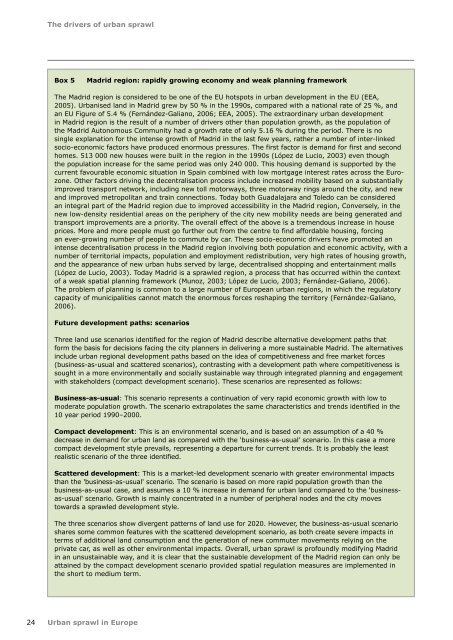Session 1 - Montefiore
Session 1 - Montefiore
Session 1 - Montefiore
You also want an ePaper? Increase the reach of your titles
YUMPU automatically turns print PDFs into web optimized ePapers that Google loves.
24<br />
The drivers of urban sprawl<br />
Box 5 Madrid region: rapidly growing economy and weak planning framework<br />
The Madrid region is considered to be one of the EU hotspots in urban development in the EU (EEA,<br />
2005). Urbanised land in Madrid grew by 50 % in the 1990s, compared with a national rate of 25 %, and<br />
an EU Figure of 5.4 % (Fernández-Galiano, 2006; EEA, 2005). The extraordinary urban development<br />
in Madrid region is the result of a number of drivers other than population growth, as the population of<br />
the Madrid Autonomous Community had a growth rate of only 5.16 % during the period. There is no<br />
single explanation for the intense growth of Madrid in the last few years, rather a number of inter-linked<br />
socio-economic factors have produced enormous pressures. The first factor is demand for first and second<br />
homes. 513 000 new houses were built in the region in the 1990s (López de Lucio, 2003) even though<br />
the population increase for the same period was only 240 000. This housing demand is supported by the<br />
current favourable economic situation in Spain combined with low mortgage interest rates across the Eurozone.<br />
Other factors driving the decentralisation process include increased mobility based on a substantially<br />
improved transport network, including new toll motorways, three motorway rings around the city, and new<br />
and improved metropolitan and train connections. Today both Guadalajara and Toledo can be considered<br />
an integral part of the Madrid region due to improved accessibility in the Madrid region, Conversely, in the<br />
new low-density residential areas on the periphery of the city new mobility needs are being generated and<br />
transport improvements are a priority. The overall effect of the above is a tremendous increase in house<br />
prices. More and more people must go further out from the centre to find affordable housing, forcing<br />
an ever-growing number of people to commute by car. These socio-economic drivers have promoted an<br />
intense decentralisation process in the Madrid region involving both population and economic activity, with a<br />
number of territorial impacts, population and employment redistribution, very high rates of housing growth,<br />
and the appearance of new urban hubs served by large, decentralised shopping and entertainment malls<br />
(López de Lucio, 2003). Today Madrid is a sprawled region, a process that has occurred within the context<br />
of a weak spatial planning framework (Munoz, 2003; López de Lucio, 2003; Fernández-Galiano, 2006).<br />
The problem of planning is common to a large number of European urban regions, in which the regulatory<br />
capacity of municipalities cannot match the enormous forces reshaping the territory (Fernández-Galiano,<br />
2006).<br />
Future development paths: scenarios<br />
Three land use scenarios identified for the region of Madrid describe alternative development paths that<br />
form the basis for decisions facing the city planners in delivering a more sustainable Madrid. The alternatives<br />
include urban regional development paths based on the idea of competitiveness and free market forces<br />
(business-as-usual and scattered scenarios), contrasting with a development path where competitiveness is<br />
sought in a more environmentally and socially sustainable way through integrated planning and engagement<br />
with stakeholders (compact development scenario). These scenarios are represented as follows:<br />
Business-as-usual: This scenario represents a continuation of very rapid economic growth with low to<br />
moderate population growth. The scenario extrapolates the same characteristics and trends identified in the<br />
10 year period 1990–2000.<br />
Compact development: This is an environmental scenario, and is based on an assumption of a 40 %<br />
decrease in demand for urban land as compared with the 'business-as-usual' scenario. In this case a more<br />
compact development style prevails, representing a departure for current trends. It is probably the least<br />
realistic scenario of the three identified.<br />
Scattered development: This is a market-led development scenario with greater environmental impacts<br />
than the 'business-as-usual' scenario. The scenario is based on more rapid population growth than the<br />
business-as-usual case, and assumes a 10 % increase in demand for urban land compared to the 'businessas-usual'<br />
scenario. Growth is mainly concentrated in a number of peripheral nodes and the city moves<br />
towards a sprawled development style.<br />
The three scenarios show divergent patterns of land use for 2020. However, the business-as-usual scenario<br />
shares some common features with the scattered development scenario, as both create severe impacts in<br />
terms of additional land consumption and the generation of new commuter movements relying on the<br />
private car, as well as other environmental impacts. Overall, urban sprawl is profoundly modifying Madrid<br />
in an unsustainable way, and it is clear that the sustainable development of the Madrid region can only be<br />
attained by the compact development scenario provided spatial regulation measures are implemented in<br />
the short to medium term.<br />
Urban sprawl in Europe











